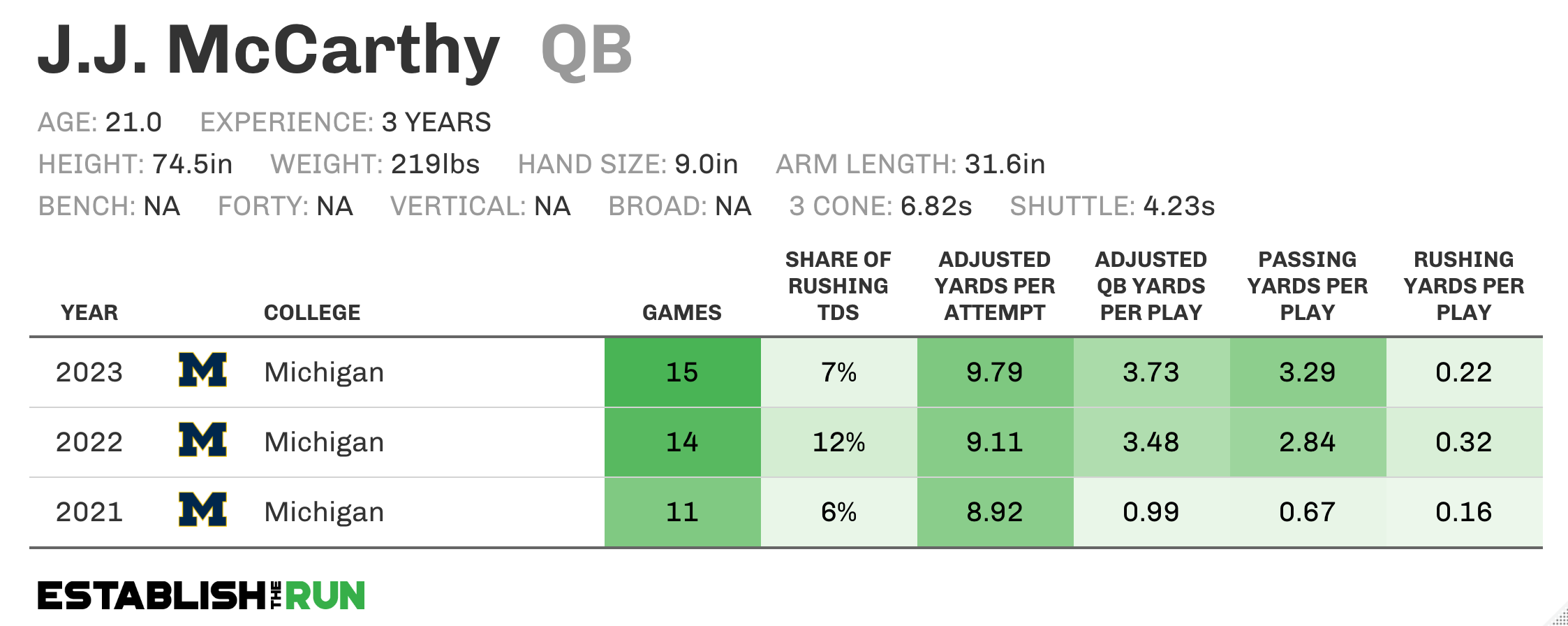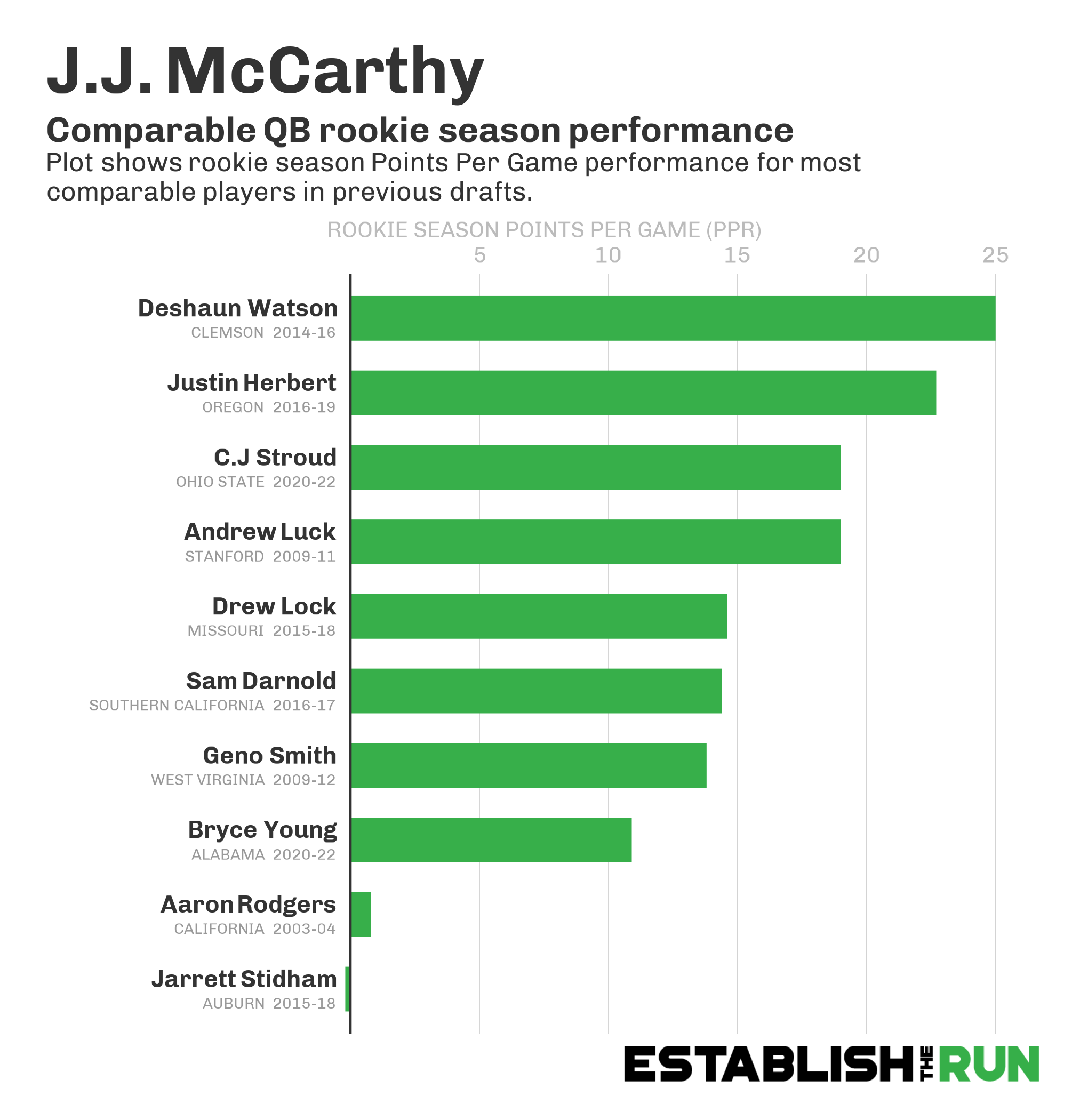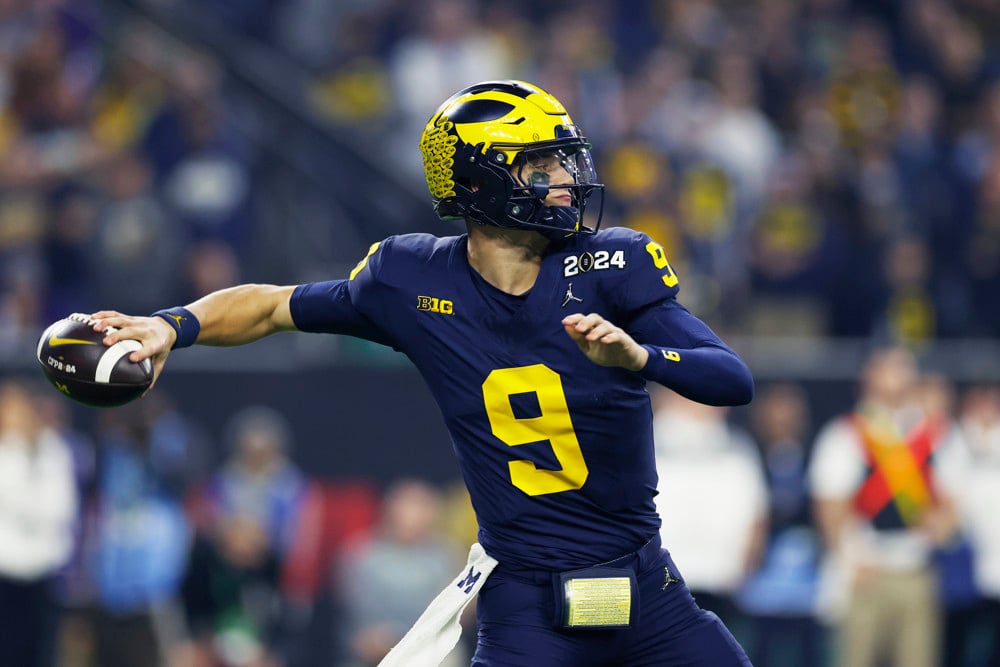Dynasty Outlook
April 8
J.J. McCarthy is our QB4 for rookie drafts and checks in as QB19 in our overall dynasty ranks. There is some potential for him to go as high as second overall in the draft, but the median expectation right now is that someone trades up to take him at No. 4 or 5. That kind of draft capital should yield both opportunity and a sell window at some point during his rookie year. McCarthy has perhaps the best comp set in this class, and fits a category of passers who have historically found success. It is fair to have questions here, but especially since he can run, McCarthy has a true QB1 ceiling long term. That is worth taking a shot on early in rookie drafts, even with an incredibly talented pass-catching class.
Profile Summary
McCarthy has been a major riser throughout the draft process, but it may be warranted. He has a great analytical profile, with strong underlying statistics. The scouts are not blown away, but note that he has plays on tape where he looks the part. The biggest issue here is the volume, as it can be a challenge to evaluate the sample size of McCarthy per game. He does bring solid mobility to the table.
Vitals
Age (as of 12/31/23) — 21.0
Experience — 3 years
Height — 74.5 inches
Weight — 219 pounds
Hand — 9.0 inches
Arm — 31.63 inches
Cone — 6.82 seconds
Shuttle — 4.23 seconds
By the Numbers

McCarthy got his first serious playing time in the second half of Michigan’s playoff loss to Georgia during his true freshman season. Cade McNamara was the starter, and was benched during the game. The pair entered 2022 battling for the job, alternating starts to open the year. Then McNamara suffered a season-ending injury, giving way to McCarthy to start the rest of the season. McNamara transferred, and McCarthy won a national championship as the starter in 2023.
McCarthy was efficient for his career, with 9.4 AYA. However, his volume as a QB leaves questions as to what the Michigan coaching staff thought of him, and our confidence in that efficiency. Famously, McCarthy did not attempt a pass in the second half of a 14-9 game against Penn State. His final season attempts per game stand out as a massive outlier compared to recent prospects.
Bryce Young – 31.7
C.J. Stroud – 29.9
Anthony Richardson – 27.3
Kenny Pickett – 38.2
Trevor Lawrence – 33.4
Zach Wilson – 28.0
Justin Fields – 28.1
Mac Jones – 30.9
Joe Burrow – 35.1
Tua Tagovailoa – 28.0
Justin Herbert – 30.6
Jordan Love – 36.4
McCarthy was at 22.1.
But sample-size questions aside, McCarthy has a pretty impressive profile. According to PFF, McCarthy finished his career with a 6% big-time throw rate, 10.1-yard aDOT, and a 14.3% pressure-to-sack rate. Since 2015, here are the QBs to have over a 5% BTT rate, 9.5 aDOT, and a P2S% under 20.
Jameis Winston
Carson Wentz
Jared Goff
Josh Allen
Sam Darnold
Kyler Murray
Jordan Love
Justin Herbert
Tua Tagovailoa
Trevor Lawrence
Anthony Richardson
C.J. Stroud
This is a very impressive list, which will also include Caleb Williams and Drake Maye once they are selected this year.
What the Scouts are Saying
Lance Zierlein makes McCarthy seem solid, but unimpressive:
Enigmatic quarterback lacking the measurables and splash throws associated with early-round quarterbacks but possessing elements that require more study and consideration. McCarthy lacks frame thickness and a plus arm. He’s fairly poised in the pocket but is average as a pocket passer. His ball placement and timing need to improve to help mitigate an average operation time due to a wind-up release. McCarthy doesn’t seek to play out of structure but is fairly consistent at making positive plays when it happens and ramps up his focus late in games and on third downs. He is confident and seems to have the ability to take slights and digest it as competitive fuel. McCarthy should continue to improve as a passer, but he fails to stand out in many of the areas that tend to be predictive of top-level success in the NFL.
Daniel Jeremiah compares McCarthy to Alex Smith:
McCarthy is a lean, athletic quarterback with a live/loose arm. He is very consistent because of his ability to always throw from a firm base, with his feet and eyes connected. He is selectively aggressive as a passer. He has the combination of velocity and accuracy to fit balls into tight windows, but he is also very comfortable taking checkdowns and piling up completions. He is very efficient. He shows the touch to take speed off the ball underneath and provide optimal run-after-catch ball location. The only throws that gave him some trouble were over-the-top outside shots, as he let too many of those leak and end up out of bounds. He is a very explosive straight-line runner. Overall, other quarterbacks in this class have more volume in the passing game, but it’s hard to argue with McCarthy’s results. I see some similarities to Alex Smith coming out of college.
Dane Brugler noted that McCarthy is a winner:
No, the Michigan offense didn’t regularly lean on McCarthy to push the ball downfield with his arm. But McCarthy executed when his team needed a play, which often came on third or fourth down. He has the arm and athletic talent that will translate well to the pro game, and his intangibles are off the charts.
Many roll their eyes at win-loss records for quarterbacks, but NFL teams care about that stat, and McCarthy finished 27-1 as a starter at Michigan with a national championship. (He also went 36-2 in high school and won a state title.)
Although McCarthy is far from a polished product, it is easy to see why an NFL team would spend a first-round pick to invest in his future.
Draft Projection
McCarthy has an expected draft position of 5.8 on Grinding the Mocks, which sources mock drafts around the interwebs. Mock Draft Database is a similar service that has McCarthy seventh overall. Jeremiah had McCarthy fourth in his most recent mock, and Brugler’s had him going seventh. McCarthy will likely be selected in the top half of Round 1.
Comparable Players
I use Principal Component Analysis to evaluate prospects. In simplest terms, this kind of analysis looks at relevant data points to find the closest comparable players in past drafts. I prefer this to a model output — which yields only a single result — as it can display the possible range of outcomes for a prospect.
Note that the analysis itself isn’t telling us how good a player is; it is simply returning the most similar players. It is then up to us to layer in context and past results to see how good we think this player may be.

The comps for McCarthy are quite impressive, and maybe even somewhat shocking versus expectations. Deshaun Watson, Justin Herbert, C.J. Stroud, Andrew Luck, and Aaron Rodgers are all QBs that have been labeled “elite” at some point in their careers. That is a lot of great comps to draw into one set. Even Geno Smith has managed to have a pretty solid second career after “busting” early. We’ll see on Bryce Young, although the start to his career hasn’t been great.
On the negative side are Drew Lock, Sam Darnold, and Jarrett Stidham. If you’re looking for a silver lining here, they are all at least still in the league. Analytically, McCarthy looks strong.


